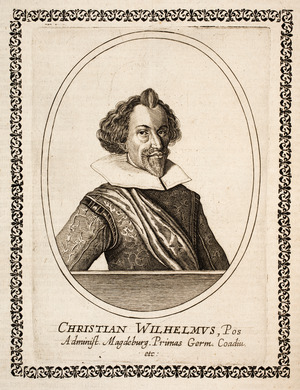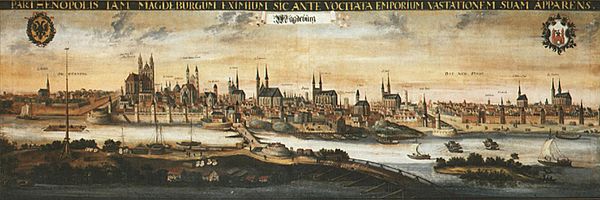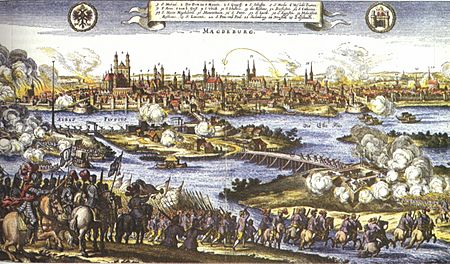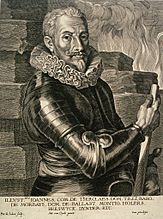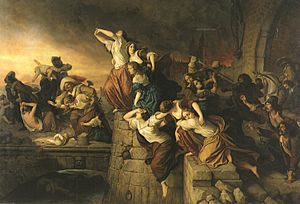Sack of Magdeburg facts for kids
Quick facts for kids Sack of Magdeburg |
|||||||
|---|---|---|---|---|---|---|---|
| Part of the Swedish phase of the Thirty Years' War | |||||||
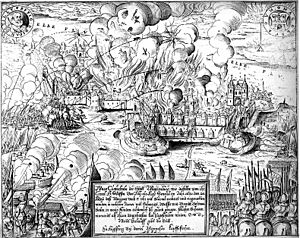 Sack of Magdeburg, 1632 engraving by D. Manasser, putting the blame on the citizens' disobedience |
|||||||
|
|||||||
| Belligerents | |||||||
| Commanders and leaders | |||||||
| Strength | |||||||
| 24,000 during the siege 40,000 during the sack |
2,400 | ||||||
| Casualties and losses | |||||||
|
25,000 defenders and inhabitants | ||||||
The sack of Magdeburg was a terrible event that happened in the city of Magdeburg on May 20, 1631. It is also known as Magdeburg's Wedding (German: Magdeburger Hochzeit). During this time, the city was destroyed by the Imperial Army and the Catholic League.
Magdeburg was a Protestant city. Around 20,000 people, including soldiers and regular citizens, died. This event is seen as the worst massacre of the Thirty Years' War. Magdeburg was one of the biggest cities in Germany back then. It had over 25,000 people in 1630. It took a very long time, until the 1700s, for the city to become important again.
Why the Sack Happened
Magdeburg's History
Magdeburg was an important religious area called an ecclesiastical principality since 968. This meant that the archbishop of Magdeburg ruled the city and its lands. He had power over both religious and everyday matters.
Becoming Protestant
The people of Magdeburg became Protestant in 1524. They joined a group called the Schmalkaldic League in 1531. This group was against the religious rules of the Catholic emperor Charles V.
During a war in 1546-1547, Magdeburg became a safe place for Protestant thinkers. This earned it the nickname "Lord's Chancellery." But it also meant the city was banned by the Empire until 1562. The citizens did not accept the Emperor's religious rules. Imperial troops then attacked the city in 1550-1551.
Protestant Leaders
By 1557, the Catholic church no longer had full control over the area. The last official prince-archbishop was a Lutheran named Sigismund of Brandenburg.
Later, Christian William of Brandenburg, who was openly Lutheran, was chosen as archbishop in 1598. But the emperor's officials did not accept him. So, from about 1600, he called himself the "Administrator" of Magdeburg. Other Protestant leaders did this too in areas that were officially Catholic.
Alliances and Conflicts
During the Thirty Years' War, Administrator Christian William made a deal with Denmark. In 1626, he led an army into a battle. After his side lost, Christian William had to leave the country. He went to stay with King Gustavus Adolphus of Sweden in 1629.
Because of these events, the leaders in Magdeburg chose a new Administrator in 1628. This was Augustus of Wettin, who was only 13 years old. He didn't take office right away because his father didn't want to anger the emperor.
New Rules from the Emperor
In March 1629, Emperor Ferdinand II made a new rule called the Edict of Restitution. This rule aimed to bring back the old Catholic ways in areas that had become Protestant. Magdeburg was one of the biggest places that the Emperor wanted to change back.
Help from Sweden
The city's leaders felt stronger when King Gustavus Adolphus arrived in Pomerania on July 6, 1630. The Swedish king was a Lutheran. Many people in Magdeburg believed he would help them against the Catholic emperor, Ferdinand II.
However, not all Protestant leaders in Germany immediately supported the Swedish king. Some thought he mainly wanted to control northern German ports. This would give him power over trade in the Baltic Sea.
In November 1630, King Gustavus sent Christian William back to Magdeburg. He also sent Dietrich von Falkenberg to lead the city's army. Falkenberg, with support from Protestant church leaders, made the city's defenses stronger and hired more soldiers.
Magdeburg Under Attack
The citizens of Magdeburg refused to pay money demanded by the emperor. So, Imperial forces, led by Johann Tserclaes, Count of Tilly, surrounded the city. The siege began on March 20, 1631. Tilly put his officer, Gottfried Heinrich Graf zu Pappenheim, in charge while he was away.
During fierce fighting, the Imperial troops, numbering 24,000 (about the same as Magdeburg's population), captured parts of the city's defenses. Tilly then demanded that the city surrender.
The Attack and Destruction
After two months of siege, Pappenheim finally convinced Tilly to attack the city. Tilly had brought more soldiers, making the total force 40,000 men. The attack began on May 20. The people of Magdeburg had hoped for help from the Swedish army, but it never came. On the last day of the siege, the city leaders decided to ask for peace. But their message didn't reach Tilly in time.
Early on May 20, the attack started with heavy cannon fire. Soon after, Pappenheim and Tilly launched their infantry (foot soldiers). The city's defenses were broken. Imperial soldiers overwhelmed the defenders and opened a gate, allowing the whole army to enter and take valuables. The city's defense became even weaker when their commander, Dietrich von Falkenberg, was killed.
Fires and Chaos
There are reports that the attackers set fire to some houses to force out defenders. It seems the fire then spread across the whole city by accident. By ten o'clock in the morning, most of the city was burning. General Tilly sent some soldiers to save the cathedral. About 1,000 people had hidden there. The wind made the flames worse, and in the end, 1,700 of the city's 1,900 buildings were destroyed.
Loss of Control
While Magdeburg burned, many Imperial soldiers reportedly lost control. The soldiers had not been paid for their service. They demanded valuables from every house they found.
Out of 25,000 people living in the city, only about 5,000 survived. At least 1,000 of these had fled into Magdeburg Cathedral. Another 600 went into a monastery. Tilly finally ordered the looting to stop on May 24. A Catholic church service was held at the cathedral the next day.
What Happened Next
A count of the people in 1632 showed only 449 inhabitants. Much of the city remained in ruins until at least 1720.
Reactions to the Sack
I believe that over twenty thousand souls were lost. It is certain that no more terrible work and divine punishment has been seen since the destruction of Jerusalem. All of our soldiers became rich. God with us.
After Magdeburg surrendered, there were arguments among the citizens. Some had wanted to fight the emperor, while others had not. King Gustavus Adolphus also joined the discussion. He claimed the people of Magdeburg had not wanted to pay enough money for their defense.
Duke Maximilian of Bavaria, a leader of the Catholic League, sent a letter to Tilly on June 1. He wished that "the enemies, powers and forces opposing Catholicism... would finally be ruined."
Pope Urban VIII also sent a letter to Tilly on June 18. He said: "You have washed your victorious hands in the blood of sinners."
The way the Imperial forces treated Magdeburg helped convince many Protestant rulers in Germany to stand against the Catholic emperor.
Lasting Impact
The destruction was so great that the word Magdeburgisieren (or "magdeburgization") became a common term. It meant total destruction and taking everything. Terms like "Magdeburg justice" and "Magdeburg mercy" also came from this event. Protestants used them when they executed Catholics who asked for mercy.
The terrible event was described by Friedrich Schiller in his 1792 book History of the Thirty Years' War. It was also remembered in a poem by Goethe. A scene in Brecht's play Mother Courage and Her Children (written in 1939) also talks about the event.
Political Changes
Administrator Christian William of Brandenburg was badly hurt and captured. He later became Catholic and was set free. He received money each year from the Magdeburg area.
After the sack, the archbishopric of Magdeburg went to Archduke Leopold Wilhelm of Austria. He was the youngest son of Emperor Ferdinand II and became the new Catholic Administrator. A peace treaty in 1635 confirmed his rule. But three years later, Swedish troops drove out the Habsburg army. They brought back Augustus of Wettin (who was first chosen in 1628) as Administrator in October 1638. Augustus finally took full control of Magdeburg in December 1642. This happened after a peace agreement with the Swedish general Lennart Torstenson. He was then able to start rebuilding the city.
The Archbishopric of Magdeburg later became a non-religious area. It eventually became part of Brandenburg-Prussia when Augustus died in 1680.
Images for kids


